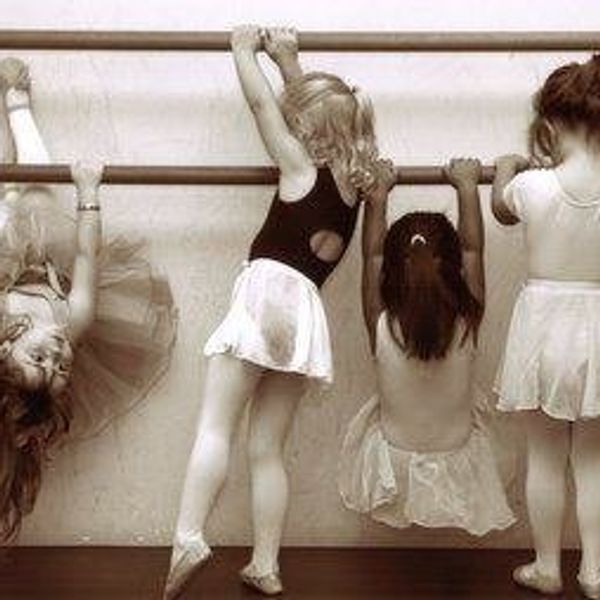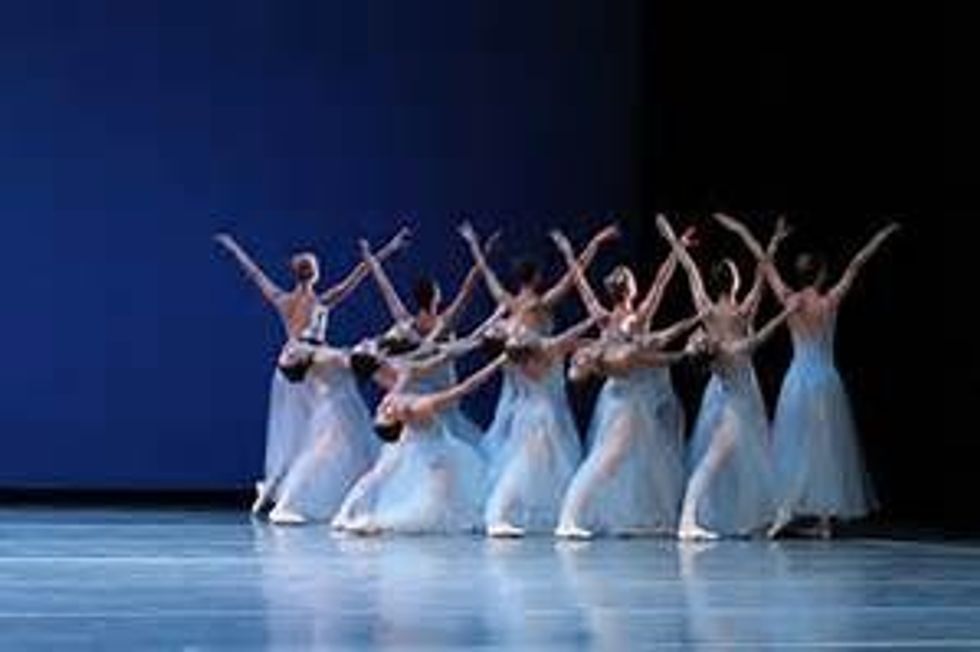A little girl’s dream is to grow up to be a prima ballerina: wearing pink tutus and tiaras, dancing on her toes in shiny pink satin shoes, and twirling to her heart’s content. I could never have predicted that this fantasy would become a reality by the time I was in high school, nor could I ever have foreseen how strenuous the process of reaching this dream would be.
I started out engaging in a little bit of everything--painting, playing soccer, doing gymnastics, dancing—all because it was merely fun for me and I enjoyed filling up my free time with different activities that I didn’t have to really commit myself to. Every day was a new adventure: I could be an artist, a performer, and an athlete all in the same week. At one point I even had planned to pursue all of my interests as careers. Similar to most naïve elementary school children, I did not realize the commitment it required to even pursue just one of these interests seriously.
By the time I was in middle school, all of my activities started to require more practices during the week and overall, more of a time commitment. My parents told me I had to quit two of my activities because there were too many overlaps in scheduling. My after school art class was a waste of time for me since I was already taking art during the school day, so that had to go. I loved gymnastics, but after coming back to it from a three year break, I realized I was very much behind the other kids my age and decided that it just was not meant to be.
So, I decided to continue with soccer and ballet. I had switched ballet schools from a small local studio to a more professional one in Natick called Walnut Hill School for the Arts. There, I started to participate in more performances such as the Nutcracker, and other shows in the spring. It was during Nutcracker, however, when I fell in love with performing. I loved the costumes, the props, the lights, the set, the audience, I even loved the seemingly endless rehearsals. But most of all, I loved that complete strangers were watching me dance onstage and connecting with me. I loved the feeling that the audience was engaged with my movement, even if I was just standing on the side of the stage as part of the scenery. When I started going to soccer games with my leotard and rolled up tights under my uniform, I knew it was time to quit soccer and commit to ballet.
It wasn’t until the end of sixth grade when I started to be more conscious about how I looked: I started wearing makeup, put some effort into the clothing choices I made, and I paid more attention to what others thought of me. It was then that I began to notice that I didn’t look like many of the other girls my age. I compared my body to the bodies of other girls in the middle school and saw that I was much bulkier than them, my legs were shorter, my torso was longer, their ribs were visible and mine weren’t, their hair was glossier than mine, their pants didn’t sit funny on their hips like mine did; I couldn’t look at anyone without thinking “if only I could look like that”. What started to bother me even more was comparing how I looked in a skin tight leotard-and-tights ensemble in relation to the other girls in my ballet class. I saw that my sides were curvy and theirs were straight, their leotards were baggy and mine weren’t; every possible comparison down to the freckles on their nose I made and using these differences, I started to criticize myself.
I started to really stare at myself in the mirror, and point out what was wrong with the way I looked. I would ask my mom if she noticed these things too and she would always say “that’s just the way you’re built”. But I couldn’t accept that.
Around seventh grade was when some of the teasing started. Both at ballet and in school, people would comment on my body, telling me I was too big, or that I was too muscular for a girl or a dancer. Those comments were all I could think about when I looked at myself in the mirror every day, they were all I could see in myself. I felt that everyone was against me, and that I was even against myself. I started to notice at ballet during costume fittings, they would have to let out the seams in my costumes, or even add a panel to the bodice so that I could fit in it and still be able to breathe. I couldn’t stand to look at myself in the mirror any longer without breaking down in tears or wishing that I had someone else’s body.
I began my quest for a solution to this problem. I would google things like “how to lose weight fast” or “how to lose muscle in your legs”. Everything was telling me the same thing: stop eating. Those seemingly normal questions became “how do I hide the fact that I’m not eating from my parents” and “what foods make you skinny”. I started lying to my parents, telling them that I had already eaten at rehearsal, or that I wasn’t hungry. I would eat maybe 5 raisins a day and tell myself that that was too much. At lunch I would sit with as many people as possible so that hopefully they would be distracted by talking to each other and not notice that I had already thrown out my sandwich—or if they did notice, I would take a few bites and then exercise more when I got home to “burn it off”. I wore baggy sweatshirts and sweatpants to hide the body I was so disgusted by. If I ate too much during the day I would punish myself by standing in the front at ballet so that I could clearly see my bloated waist in the mirror during class. By this time, I was on the borderline of having an eating disorder.
My mother has always said that ballet was what started it, but I think that it was middle school just as much as ballet. Girls in middle school are nasty. They haven’t learned how to filter what they say or think before they give you a funny look. But by the time I got to high school, the girls had been tamed and knew that how they were behaving was immature and learned to respect people’s differences. More recently in the media, there has been a large campaign for women to love their bodies no matter what size or build they are. However, the ballet community is slow to follow this encouragement. Everyone knows that if you aren’t tall, skinny, and pretty you can’t be a professional ballet dancer. There are even certain schools that require you to maintain a certain weight in order to be accepted to their program—they will even kick you out if you gain too much weight. In regards to body image, ballet is similar to modeling, where everyone is presumed to have an eating disorder and look a certain way. I don’t think I realized the extent of the reality of this stereotype until I started to go to other ballet schools during the summer.
My first summer away from home I went to a program at SUNY Purchase called the American Academy of Ballet. You had to be admitted by audition, however it was not a very selective program. I was placed with roommates that were much older than me, and in a level I presumed to be very low. Thus, I was miserable. To distract myself, I would stay after class and work on corrections that my teachers had given to the class during the day. I was always working hard and practicing to get better. By focusing more on the dance aspect of ballet rather than the body image, I became less aware of how different I was from others in my class. I became a stronger and happier dancer that summer; I was even selected out of the 200-plus girls at the program to receive a “Most Improved” award. Dancing satisfied me, and I didn’t have to worry about anything else.
However, this content was short lived, for when I returned to my home studio the vicious cycle began again: I wouldn’t fit in costumes, the teachers would comment about how I was too bulky, and all the little demons in my head awoke again and fed on my self-hatred.
The next summer, I attended the Walnut Hill Summer Dance program, where I spent five weeks living and dancing on the campus I already had started to consider my second home. I forgot about my body for the majority of that program, since our days were packed with classes and rehearsals and body conditioning—I had no time to worry about anything other than dance. But then one day, we were all sitting at lunch, and I overheard a girl at another table say something about me. She said, “You know that girl who always matches her headbands to her leotards?”, which was something only I did, “I feel bad for her because, I don’t know, she’s just so…big”.
Once I heard that, I went swirling down into my dark hole again. I isolated myself and for the rest of that day, I didn’t eat a thing.
Interestingly enough, the next day we had a campus-wide assembly. The director of the dance department got up on the stage and talked about requirements for our dress rehearsal, and other information we needed to know. At the very end, on a more serious note, he said that he had heard that there had been some bullying going around at the program. I hadn’t told anyone about what had happened the day before, so it seemed as if he were reading my mind. He told us that it was not tolerated at the school and it needed to stop immediately. Even though I knew it was not me he was talking about, it made me feel supported and cared about. I told myself that what that girl had said about me may be true, but maybe I shouldn’t let it hurt me so much.
For the rest of that summer, I just enjoyed dancing and performing. I loved the guest teachers and the master classes and all of the extra seminars we had the privilege to go to, including one about nutrition. The nutritionist addressed the fact that a lot of dancers either do have, or are stereotyped to have an eating disorder. She explained how bad this was for your body and how dancers especially—with all of their injuries and strenuous use of their muscle—needed a balanced and healthy diet. This included not skipping meals because you feel bloated, but instead eating a leaner snack, or spreading your meals throughout the day instead of eating three big ones at designated hours. She emphasized that when you’re hungry, your body is telling you that you need to eat, and by ignoring that you are causing more harm to yourself not only in terms of survival, but in terms of dancing.
It clicked in my mind that in order to be the dancer I wanted to be, I needed to let my body be how it naturally wants to be, and that not eating would not get me to that place. I was still concerned with how my body looked, but I was not willing to go to such extremes to get it to where I wanted it to be.
For the next couple of years, I had good days and bad days when it came to how I looked at myself. I would forget about my self-image entirely and then something would happen that would trigger the dark place in my head. This cycle continued for a couple of years until it was time for me to leave Walnut Hill. Leaving opened up so much for me to explore in the dance world. I began taking classes at two different studios—one in the town next door during the week, and one in downtown Boston on Saturdays. I had no idea what to expect from the Boston studio since I hadn’t really heard of anyone who had gone there.
It was unlike any experience I had ever had. Never had I been surrounded by such talented dancers with so many different backgrounds and body types. When I danced there, I felt unrestricted by my body type. The classes were geared towards everyone instead of the favoritism I had experienced before. It helped me realize my immense potential when I was able to be confident in myself not only as a dancer, but also as an individual. I had always loved dance, however dance did not always make me happy, but there, I realized that it was the only medium through which I was truly content with myself. I found something within me that not only made me a better dancer, but also a better performer. I had always enjoyed performing, however I hadn’t really grasped the true meaning of performance until this point in my career.
However much I enjoyed my experience at the studio in Boston, I was incredibly unhappy with my experience at the studio in the town next door and unfortunately, Boston was too far for me to commute every day, so I had to seek another option. I had heard that the politics at Boston Ballet School were nearly unbearable and that many people did not like it there. Nonetheless, I decided that I was going to try it out for myself—that is if I could get into the school. I auditioned in mid-January, which was right in the middle of their rehearsal process for their spring showcase. I was able to take a class with one of the intermediate levels and right away I could tell that the rumors I had heard weren’t completely truthful. The teacher did seem to have favorites in the class, however it was not to the same extent as it had been at other places. From what I could tell from that one class, it was the perfect environment for me to progress in. The students were all very serious about their work in class and I finally felt like I wasn’t the only one taking ballet so seriously. I was placed in the first of the two advanced levels—which was much higher than I thought I would be placed—and was able to participate in their production of the Four Seasons with music by Glasnost. Rehearsals were long and tedious, but I was happy to be able to perform with the Boston Ballet School.
But then came the dreaded costume fittings. They were making their own costumes that year that consisted of a bodice and a romantic tutu (the kind that are long and flowing) both of which were fitted with hooks in the back to keep them on. Because I joined the school in the middle of their rehearsal process, they had ordered the bodices and skirts before I was able to be measured and properly fitted. The costumers pulled and heaved and tried as hard as they could to fit me into a costume that was meant for a twig, but the hooks just wouldn’t reach all the way around my ginormous ribs. They began talking about how they would have to order a new costume for me and I couldn’t listen to any more. I asked to be excused and ran into the hallway, plopped down in the corner and began to sob. Just when I thought I had jumped the hurdle at last, it caught me and I came tumbling down. I was back to being “the big one”. I was humiliated. Devastated.
Eventually, the principal of the studio found me crying in the hallway. She guessed at what was wrong and asked if I wanted to see a nutritionist. She was not informed of my history with the matter of my body, and so she couldn’t really have known that by saying that she just made me feel even worse. My mother eventually told her and she apologized and said that she would support me if I needed it. Ever since, no one at Boston Ballet has commented on the nature of my body.
However, the following winter—which was also audition season for summer programs—I had a bit of a perspective-altering experience. I was auditioning for the school that I had attended for the previous two summers as a sort of “safety” just in case I didn’t get into any of the other programs I wanted to go to. This school, called the Rock School for Dance education, is famous for producing dancers that spin like tops, jump like they can fly, and that are as flexible as a human rubber band. They also are one of the only schools that will give you the results of the audition right then and there (most places email you within two weeks with your results). As the class finished, the dancers were called up to the judges table one by one, where the two directors—husband and wife—sat and gave them a pamphlet stating whether or not they were accepted and what level they were accepted into, and sometimes they added some corrections that the individual needed to work on in general. As they called my number, I approached the table. They smiled at me and asked how I was doing and said that it was good to see me again. What they said next was something I would never have expected.
“We think you have the potential to be a professional dancer…if you were to lose some weight. It just doesn’t look good and it won’t be easy for partners to lift you, we suggest you seek help from a nutritionist if you really want to seriously pursue a career in dance…”
My heart felt like it was going to burst out of my chest. I couldn’t hear the rest of what they were saying to me; all I could hear was the blood pumping in my temples. They handed me my pamphlet: the box for accepted was checked, and next to it, it said “level 6” (which is the highest level in the summer program), “More appropriate weight”.
I walked out of the studio speechless. My friend was waiting for me and asked me what was wrong; I was in shock and I couldn’t answer him until we had reached the train station.
On the train ride home, I surprised myself. I wasn’t sad or ashamed of myself like I would have been in the previous years; I was furious. The only think I could think of was “How dare they”. How dare they undermine my years of hard work just to tell me that I didn’t look the way they wanted me to look? I wished that I could go back and give them a piece of my mind. For the first time, I wanted to defend myself instead of agree with them and pity myself. I never cried over it, however I did put the pamphlet in the paper shredder and enjoyed watching the paper disappear.
This did not signify that I was cured of my negative outlook, however it showed immense progress in my vision of myself. I was able to see how wrong they were and use their criticism as a motivation to work even harder and to be an even better dancer. I wanted to prove them wrong and show that I could be an even better dancer than those skinny, sickly twigs they idolize in the ballet world.
To this day, I still have doubts about my body, for those demons in my head will never go away. I still look in the mirror and don’t love what I see, I still have trouble getting my thighs to fit in fifth position, I still compare myself to the girls in my class. I don’t think that aspect of my perception of myself will ever go away; however, the way in which I manage and act upon this perception is what I feel I have made immense progress in. I can’t say that I’m confident in who I am, but I can say that I am comfortable enough with myself that I don’t have the need to alter my appearance to be content. I have come to terms with the fact that I don’t have a typical dancer’s body and decided that I don’t want to be a typical dancer; I want to be an extraordinary one.





















